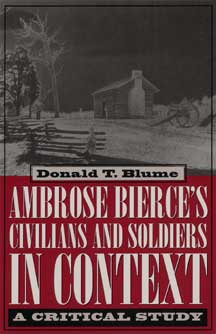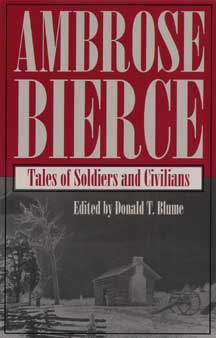
ambrose bierce's civilians and soldiers in context: a
critical study. by donald t. blume. (kent, oh: kent
state university press, 2004.)
tales of soldiers and civilians. by ambrose bierce.
originally published 1891 [1892]. edited by donald t. blume.
(kent, oh: kent
state university
press, 2004.)
new
new
companion volumes from
kent state university press present both donald t. blume's fresh
editorial treatment of ambrose bierce's
key 1892 collection tales of soldiers and civilians,
and his exhaustive critical analysis of the genesis and revision
of the
tales in the light of their periodical contexts.
virtues first: blume has clearly read more of bierce's journalism
than any other scholar who has tackled editing or criticism of
bierce's fiction. ambrose bierce's civilians and soldiers is
thus the best-informed study of bierce's writing practices ever
published. blume understands keenly that bierce's fiction and
journalism are of a piece, not separated by artificial generic
barriers.
the editorial care blume takes in his reconstruction of the 1892
tales of soldiers and civilians is also worthy of considerable
praise. this edition is meticulous and beautifully-produced.
supplementary primary material from bierce's journalism abounds.
apparatus is kept to a minimum, but with the help of ambrose
bierce's civilians and soldiers in context, academic readers
can trace blume's major editorial interventions.
and they are interventions. blume's version of tales of soldiers
and civilians is admittedly "an eclectic one informed by
my judgment" (xxvii). not offering a strict diplomatic version
of the 1892 text, blume instead attempts to present the 1892
volume as an integral artistic whole. he usually rejects revisions
that bierce made in the several ensuing editions, but is attentive
to variant readings from the first periodical publications.
i can wholeheartedly recommend blume's edition of tales of
soldiers and civilians for academic library collections and for bierce
fans inside the academy and out. for the first time since 1892,
we can see bierce's collection as a unified work of art, unobscured
by the exigencies of later collected and selected editions.
i can recommend ambrose bierce's civilians and soldiers in
context too, although merely as an ancillary companion to the edition.
unfortunately, it's not very readable as a critical essay, and
its interpretive claims are often strained and sometimes curiously
extreme.
the tone of the study is set by blume's analysis of bierce's "a
holy terror," the first of the "soldiers and civilians" stories
to be published. blume's typical interpretation is well-illustrated
here. he conceives of an ideal reader for one of bierce's tales
as someone who has read attentively, indeed nearly memorized,
bierce's journalism. such a reader has been indoctrinated by
bierce in appropriate hermeneutic strategies. "to read 'a
holy terror' as bierce meant it to be read by those who could
unlock its secrets, it is essential that the wasp's
role as the story's original host publication be understood" (5).
puzzling to me is not so much the insistence on contextualizing,
which
is standard 21st-century critical practice, but the suggestion
that bierce offers secrets to unlock. for blume, reading bierce
is an initiation into esoterica. readers who have been through
an apprenticeship as decoders will succeed, but the master has
deliberately sealed up his lore in occult packages.
i don't know why a popular newspaper writer would be so intent
on hiding his meanings from anyone but an acolyte. but bierce
was a strange man, and perhaps he was so intent. the problem
in blume's readings is that once we have unmasked the real meaning
beneath the ostensible ones, there isn't all that much to show
for our efforts.
in the case of "a holy terror," for instance, the secret
at the center of the tale turns out to be nothing more than an
assertion that bierce is more satirical than farcical. in readings
of other tales, blume's self-proclaimed critical incisiveness
turns out to be little more than a detection of ironies (see
the readings of "one of the missing, "a tough tussle," and "the
horseman in the sky"). on the best-known story in the collection, "an
occurrence at owl creek bridge," blume's innovation is to
read the death of peyton farquhar as occurring over a period
of fifteen minutes rather than being near-instantaneous, as the
story implies and most readers assume. the result is a belabored
excursus on hanging and death thereby that does not materially
alter any of the dramatic effect of the story.
i don't mean to comment too harshly on blume's exceptionally
well-supported readings of bierce. but the tone of his interpretations
here is often querulous over what turn out to be exceedingly
small matters. readers will return from a close look at the trees,
however, with a new appreciation of the forest of bierce's art,
as informed by blume's venture into bierce's workshop of 19th-century
periodical publication. 
how can i get online jobs without investment
professor of english
university of texas at arlington



